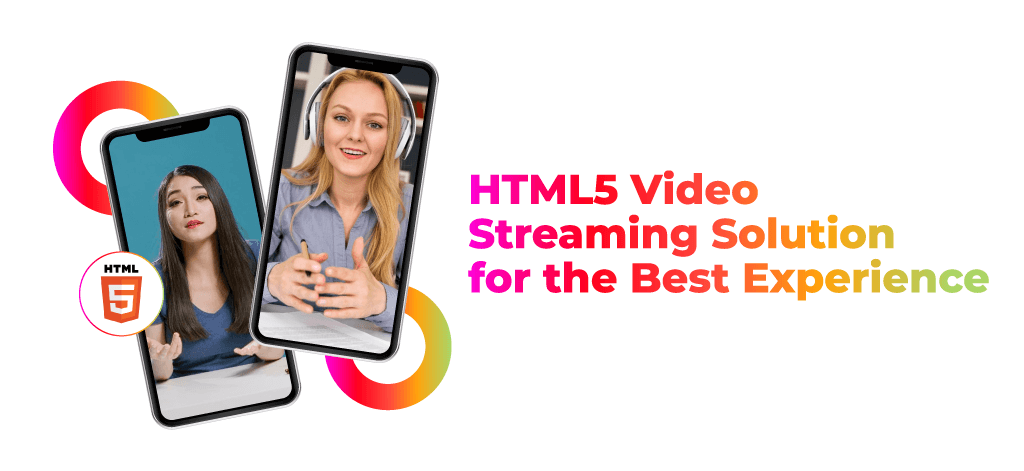Online video consumption has become an integral part of many individuals since multiple industries and organizations are using video formats to engage their audiences. HTML5 video streaming has emerged as a powerful solution that delivers high-quality video content across multiple devices. This new standard of video playback allows for manipulation of multimedia content using <audio> and <video> HTML tags.
HTML5 streaming gives the benefit to broadcasters or streamers to upload secure video streaming content. This is to give their audience the best quality experience using some basic understanding. With the help of this streaming solution, live streaming and secure uploading of content has never been more accessible. In this blog, we are going to explore what is HTML5 video streaming, how it works, what are its benefits, and more.
What Is HTML5 Video Streaming?
HTML5 video streaming is an innovative method that facilitates the delivery of audio and video content over the internet through the latest version of the Hypertext Markup Language (HTML). HTML5 eliminates the need for third-party plugins like Adobe Flash, providing support to seamlessly embed multimedia elements directly into web pages or content delivery platforms. This enhanced technology has changed the online video streaming industry by providing a more efficient and standardized approach to broadcasting audiovisual content.
How Does HTML5 Streaming Work?
While HTML5 streaming is an enhanced and efficient way of streaming high quality content over the Internet. It is crucial to understand how this technology works so that you can seamlessly integrate it for your streaming needs.
Integration of <video> Element
Developers use the <video> element within HTML5 to embed video content directly into web pages or streaming platform. This video element serves as the container for the video content, allowing for seamless integration within the HTML5 video streaming platform.
Interpretation by the Browser
When a user accesses a web page embedded with HTML5 adaptive streaming video content, the browser or platform interprets the <video> element and understands that it contains multimedia content to be presented.
Codec Utilization
Codecs are software or hardware components that encode and decode digital data. The browser easily identifies the appropriate codecs required for the specific video format. HTML5 streaming supports various video formats, such as MP4, WebM, and Ogg. This provides enhanced flexibility for content creators.
Decoding and Display
The identified codecs are utilized to decode the HTML5 video file. This involves converting compressed data into a format that can be displayed or broadcasted. Once done, successfully, the browser displays the adaptive video streaming HTML5 content on the audience’s screen within the designated <video> element.
Streaming in Segments
Rather than waiting for the entire video to download before playback, HTML5 streaming employs a segment-based delivery approach. The video file is divided into smaller, manageable segments. They are progressively loaded and played, allowing users to stream without any significant buffering delays.
Adaptive Bitrate Technology
A key feature of HTML5 video streaming is the use of adaptive bitrate technology. This technology allows adjusting the video quality during playback based on the audience’s internet speed and device capabilities. The adaptive HTML5 streaming allows enhanced video quality if the connection is strong and if it weakens, the quality adjusts to prevent buffering interruptions.
Real-time Adjustments
Adaptive HTML5 streaming continuously monitors the viewer’s internet speed throughout the playback session. Real-time adjustments to the bitrate ensure a smooth and uninterrupted viewing experience, optimizing the balance between video quality and streaming performance.
Compatibility Across Platforms and Devices
HTML5 streaming compatibility with various video formats and its adaptive nature makes it suitable for a wide range of video streaming platforms and devices. Whether audiences access the content through a desktop, laptop, tablet, or mobile device, it ensures a consistent and enhanced viewing experience.
Top Benefits of Using HTML5 for Video Streaming
While there are many great things about how HTML5 for video streaming works. There are more advantages that this enhanced solution can provide. Here are the top benefits of using this technology:
Cross-platform Compatibility
HTML5 video streaming has remarkable cross-platform compatibility, offering a seamless viewing experience across an array of devices and browsers. Whether audience access content on desktops, laptops, tablets, or smartphones, it ensures consistency and reliability. This eliminates the frustration of compatibility issues and allows content creators to reach a broader audience without compromising quality.
Improved User Experience
Adaptive HTML5 streaming has the ability to deliver an unparalleled user experience. By seamlessly adjusting the video quality based on the audience’s internet connection, it ensures smooth playback and minimal buffering. This real-time adjustment capability caters to varying network conditions and provides users with an immersive and enhanced viewing experience. This results in streamlined streaming without any interruptions that often occur during traditional, non-adaptive streaming methods.
Responsive Design
The responsive design of HTML5 streaming enables video content to seamlessly adapt to diverse screen sizes and resolutions. Whether users are accessing content on a large desktop monitor or a compact mobile screen, it ensures that the video adjusts appropriately. Responsive design enhances accessibility and satisfaction, fostering engagement across all devices.
Reduced Dependence on Plugins
HTML5 streaming reduces dependence on third-party plugins, notably eliminating the need for Flash or dependency on Plugins. This shift not only enhances security by minimizing potential vulnerabilities associated with plugins but also contributes to overall performance. Audiences can enjoy video content without the hassle of installing additional plugins, simplifying the process and ensuring a streamlined and secure experience.
Adaptive Bitrate Technology for Bandwidth Efficiency
One of the key advantages of adaptive HTML5 streaming is its incorporation of bitrate technology, optimizing bandwidth efficiency. This technology adjusts the video quality based on the audience’s internet speed. Moreover, it helps prevent overconsumption of bandwidth and not only ensures a smoother streaming experience but also makes the best use of available resources.
Enhanced Analytics and Audience Insights
Adaptive HTML5 streaming allows for more sophisticated analytics and audience insights. Content creators can gather data on the audience’s viewing habits, device preferences, and network conditions. This information enables informed decision-making, helping to tailor content strategies, optimize delivery, and enhance overall satisfaction.
Which Streaming Protocol is Used for HTML5 Streaming?
HTML5 video streaming is facilitated by multiple protocols, two of the most popular ones are HLS (HTTP Live Streaming) and MPEG-DASH (Dynamic Adaptive Streaming over HTTP).
HLS (HTTP Live Streaming)
Developed by Apple, HLS has gained popularity as a leading protocol for delivering adaptive streaming over HTTP. The methodology employed by HLS streaming involves segmenting video content files into smaller and more manageable segments. These segments are then adjusted based on the internet speed, optimizing the bitrate for an optimal viewing experience. HLS’s compatibility extends across various devices and platforms, making it a robust choice for HTML5 streaming.
MPEG-DASH (Dynamic Adaptive Streaming over HTTP)
An open standard for adaptive video bitrate streaming, MPEG-DASH supports a diverse array of browsers and devices. This protocol provides a standardized approach to content delivery, offering versatility for HTML5 streaming. Moreover, like HLS, MPEG-DASH employs the segmentation of video files into smaller segments. This adapts the bitrate to accommodate fluctuations in the audience’s internet speed. MPEG-DASH fosters broad compatibility, making it an excellent choice for delivering high-quality video content through HTML5 video streaming.
Final Thoughts
HTML5 video streaming is a great way to enhance the audience experience. This technical advancement can provide seamless and smoother transitions during video streaming. It is easier to integrate this solution into your video streaming platform or web page. Moreover, it can enhance the live streaming experience while hosting events. If you are looking to organize virtual events or live streaming sessions, then Dreamcast can offer you robust integrations. That is tailored and customized according to your event needs. Book a demo now and learn more.
Connect with the Industry's Most Experienced
Live Streaming Service Providers.




















